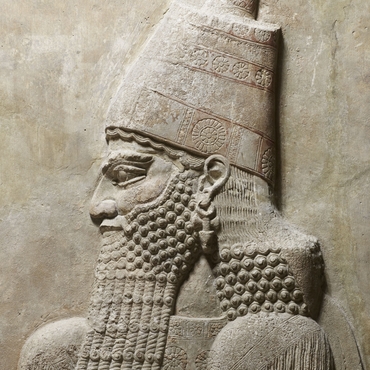
- Home
- The luxury of an Assyrian palace
- Narrative reliefs
- Executing the reliefs
The material
The palace reliefs are carved on orthostats of gypsum alabaster. Since it was readily available in Assyria, it is also known as "Mosul marble”. As a soft stone, it could be worked more easily by the sculptor and leant itself to a variety of decorative details. Since the stone is so fragile, however, some of the reliefs were lost and crumbled to pieces when archaeologists unearthed them. Many reliefs are only known today through drawings.
Construction
Some orthostats are over 4 metres tall and some 20 cm thick. The base of the slabs was buried in the ground. Traces of bitumen suggest they may have been coated to protect the base from moisture. The upper part of the reliefs bore traces of the metal clamps and dovetails used to secure them to the walls. They were probably fixed to wooden beams embedded in the brick walls. There are inscriptions in Akkadian cuneiform on the reverse of each slab.
Traces of polychrome painting
We know that the reliefs in the palace of Khorsabad were painted, at least in part. Traces of paint remain on some of them, such as the relief of the Medes tributaries, with red for the horse harnesses, and black for people’s hair and beards. The same colours - black, red and blue - are also found on surviving paintings. We do not know if the reliefs were completely painted or only in certain areas.
Associated media
Open Media Library

Relief of Sargon (detail): head of King Sargon

Relief of Medes tributaries (detail): horse head with traces of polychrome

Painting from Til Barsip (copy): winged human-headed bull and genius

Fragment of decoration: brick adorned with a foot

